Just like that, another season is in the books…..for the Detroit Red Wings at least.
In a season where most of the chatter coming out of “Hockeytown” centered around the team’s rookies, the Red Wings saw varying levels of performance from each and every one of their players. For general manager Steve Yzerman, his staff, and many writers at the national and local level, now is the time to evaluate these players and determine whether their seasons were a net positive or a net negative. Much like last season, I took it upon myself to administer the “ultimate eye test” by watching every game this season while tracking whether players were doing good things or bad things on the ice.
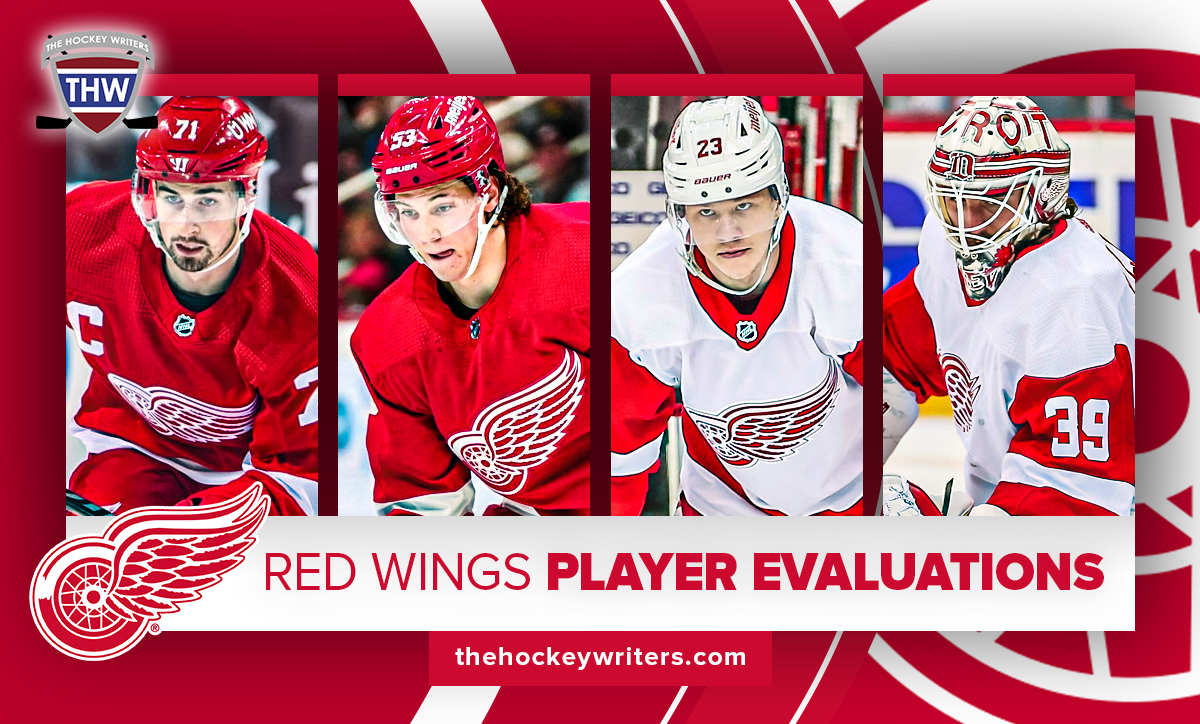
This year, based on reader suggestions, I’m adding a grade element to these evaluations. It’s not enough to say Player X was a net positive for his team; pre-season expectations must also be weighed, and whether or not that player met those expectations will factor into their grade. With that in mind, the players are listed here in the order of their grades. In each player’s section, I’ll mention whether they were a net positive or a net negative. For this article, I’m only looking at players that played a minimum of 20 games for the Red Wings this season, though I made a single exception for defenseman Jake Walman, as he played 19 games and missed one due to illness.
Related: Red Wings 2020-21 Player Evaluations
Before we begin, it is also important to note that this is all based on my observations and what I want to see from these players. Because of that, there’s plenty of room for debate with these rankings, and I highly encourage you to share your thoughts in the comments section at the bottom of this article.
Now let’s begin.
Red Wings Forwards
Tyler Bertuzzi – A
Tyler Bertuzzi took his game to another level this season, there’s really no other way to put it. He recorded the first 30-goal season of his career, and his .91 points per-game average this season was easily the highest rate of his career. The 27-year-old posted good possession numbers at even-strength, and his presence on the Red Wings’ top line was something the team missed whenever he was out of the lineup.
Whether he was making shifty plays in the offensive zone or putting his body on the line in the defensive zone, Bertuzzi showed a real proficiency at both ends of the ice this season. After missing all but nine games last season, he did everything in his power to come back and stake his claim as one of the premiere players on this team. I would have been content with 20 goals and 50 points from “Bert” this season, but he blew away those expectations with relative ease. His play this season sets the bar for next season, but we’ll cross that bridge when we get there. As for this season, he had the most positive effect on his team.
Dylan Larkin – A
After this season, I feel very confident in saying that Dylan Larkin is the Red Wings’ best forward, at least in 2022. So then why is he second on this list instead of first, you might ask? Well, it’s a matter of expectations. After a dreadful 2020-21 season where he managed just 23 points in 44 games, my expectations for the Red Wings’ captain was to return to form as a top center and quiet some of his naysayers. With 69 points in 71 games and some of the best possession stats on the team, he met those expectations – but he did not exceed them.
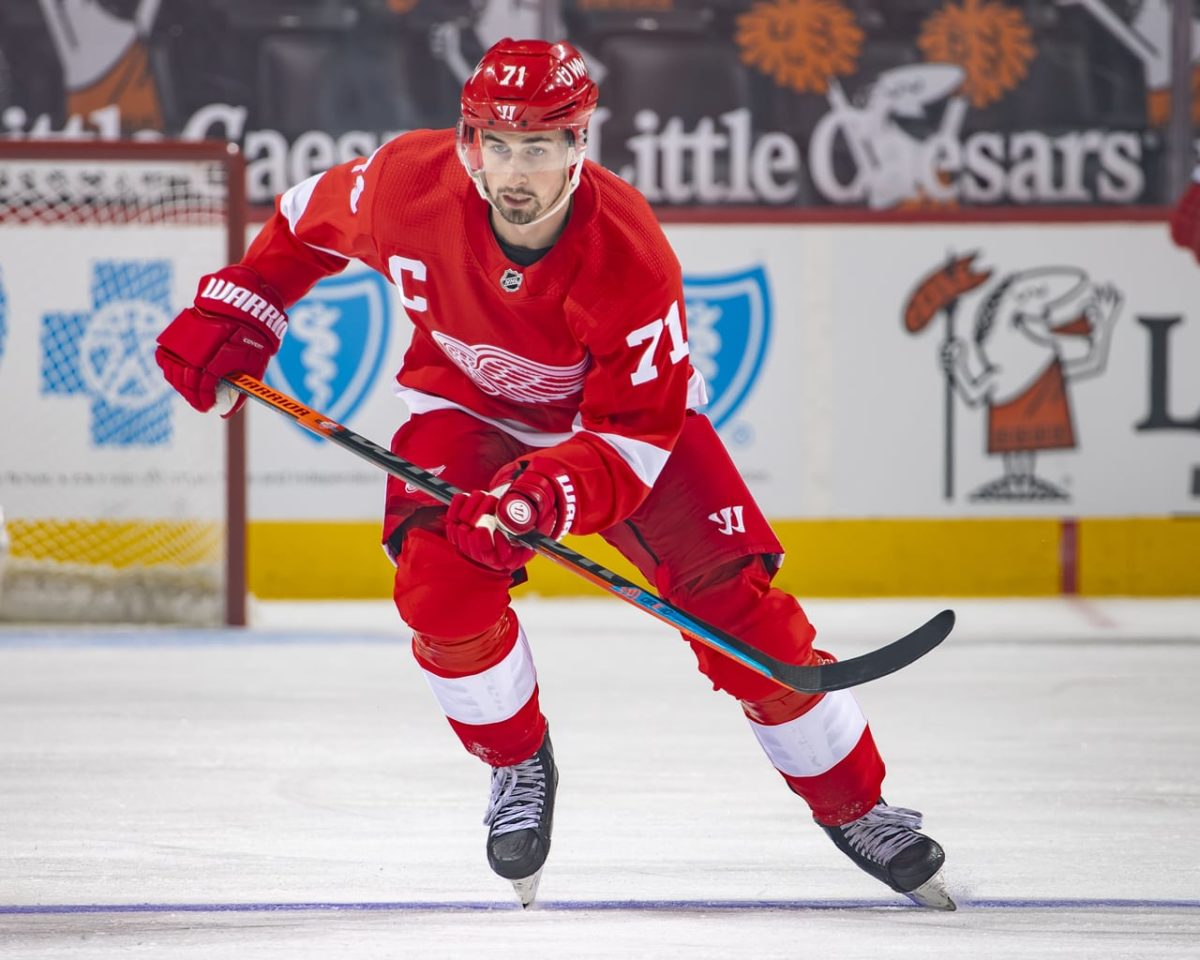
Two things stuck out about Larkin this season: his ability to make his linemates better (a certain rookie benefited greatly from playing on Larkin’s wing all season) and his willingness to be involved with the physical side of the game. A player coming off of a neck injury like the one he sustained at the end of last season would probably not be eager to be involved in shenanigans that happen after the whistle. Yet there he was, standing up for himself and his teammates, even if it just meant giving somebody a quick shove and telling them to cut it out.
He put himself back on the map, nationally speaking, this season, and now it’s about maintaining that level of play while the roster around him continues to get better and better.
Lucas Raymond – A-
If you’ve read my work or listened to THW Grind Line at all this season, you probably know how much I like Lucas Raymond. Despite how hyped I was about his first season in North America, I truly believed that he would start the season in the American Hockey League before making the jump to the NHL. I was laughably wrong, and I will gladly own that. To say the 20-year-old exceeded my expectations would be an understatement.
With Raymond in the lineup, the Red Wings’ offense added another dimension to it. During the first two months of the season, he was probably the favorite for the Calder Trophy, awarded to the NHL’s Rookie of the Year. Throughout most of the season, he was stapled to Larkin’s line, and the rookie was a big reason why the captain had a resurgent season. However, Larkin also played a big role in elevating Raymond’s game. According to Natural Stat Trick, Raymond’s offensive and possession numbers took a BIG dip without Larkin on his line; without Raymond on his line, Larkin’s numbers went up. Raymond was not immune from making rookie mistakes, and when he hit the “rookie wall” that so many hit, it was painfully obvious.
Still, Raymond never went more than four games without recording a point this season. In establishing himself as a foundational piece for the Red Wings this season, he made a lot of fans a lot less upset about missing out on the first overall pick in the 2020 draft.
Jakub Vrana – A-
From the very first game Vrana rejoined the Red Wings, the mind began to wonder where this team would be if they had him in the lineup from the beginning of the season. His 13 goals in 26 games equates to 41 goals over a full season, and he now has 21 goals through 37 games since coming over at the 2021 trade deadline. There are a handful of positive things that he does, but the thing that stands out the most is that he seems to be the only player on the roster right now that can score when you least expect it. Scoring on nothing-plays is a skill that not many players possess, but Vrana does.
Vrana is the reason I knew I’d have to reiterate the fact that I grade and evaluate players based on a personal criteria. It frustrates me to see players look disengaged in the defensive zone, regardless of how exceptional they are on offense. The absolute worst thing that can happen when he is on the ice is the opponent pins Detroit in their own zone. This is why he fell out of favor with Washington Capitals coach Peter Laviolette, and while I still think it was crazy of Laviolette to ever make Vrana a healthy scratch, I saw that lack of effort in the defensive zone in his 26 games this season. Couple those defensive issues with a few mistakes with the puck here and there, and that’s why he doesn’t rank higher here. Still, he blew my expectations out of the water, and that certainly counts for something.
Michael Rasmussen – B+
Just like last season, Michael Rasmussen ranks in the top five among forwards based on my evaluations. While a strong finish to the season definitely helped him climb the ladder, I was impressed by how many good notes I had about him throughout the season. In fact, most of the bad notes I had on him had to do with him not playing up to his size; in my opinion, anybody who stands at 6-foot-6 and 230 pounds should not be so easy to knock around. Part of what made the last month or two of his season so successful was that he figured out how to use his size and power to wreak havoc in the offensive zone.
The 23-year-old has a deceptively good shot, and he put it on display multiple times throughout the season. If he had a breakaway, his approach was to snipe it past the goalie, and he was successful at doing so a handful of times this season. In general, Rasmussen is a player that excels when he keeps things simple, and he allows himself to play with an edge. Mean Ramsussen is a dangerous Ramsussen.
The key for him heading into next season is consistency. Over the last two seasons now, we’ve seen what he’s capable of when he’s on his game. If he can put it all together and stay on his game more often than not, the Red Wings should have a quality bottom-six player on their hands that should be capable of playing on both the power play and the penalty kill.
Sam Gagner – B+
Sam Gagner ranked fifth in last year’s evaluations, and while he isn’t that high in this year’s edition, he remains an underappreciated member of this Red Wings team. At 32 years old, his best days are behind him, and yet he posted his best offensive numbers since the 2017-18 campaign. His 13 goals ranked sixth on the team, and he found ways to chip in despite averaging just 13:37 in ice-time. He made an impact on the penalty kill, and when Larkin and Marc Staal were out of the lineup towards the end of the season, he wore an ‘A’ on his sweater as an alternate captain for the Red Wings.
Gagner isn’t the kind of player that should be playing with a team’s top skill guys because he just isn’t able to convert the way he used to early on in his career. I noticed him misreading or misplaying offensive situations a number of times throughout the season. That being said, it’s a testament to his play this season that, despite his declining offensive abilities, he was still able to post the kind of numbers he did. I think his role in Detroit is perfect for where he’s at in his career, and it is my opinion that Yzerman should seriously consider offering him another deal to return to the Red Wings.
Pius Suter – B
I won’t lie: in organizing my notes and making the necessary adjustments, I was surprised to see Pius Suter rank this high. He rarely stood out in the same way that Bertuzzi or Larkin did on a more regular basis, but Suter frequently made those small, underappreciated plays that help a team over the course of a game. The offensive side of his game was on display when he skated alongside Bertuzzi and Robby Fabbri – dubbed “The Guelph Line” due to their time as teammates with the Guelph Storm of the Ontario Hockey League. Conversely, his time skating between Jakub Vrana and Filip Zadina showed off the two-way side of his game as he was tasked with playing a more responsible game while the “Czechmates” let loose in the offensive zone.
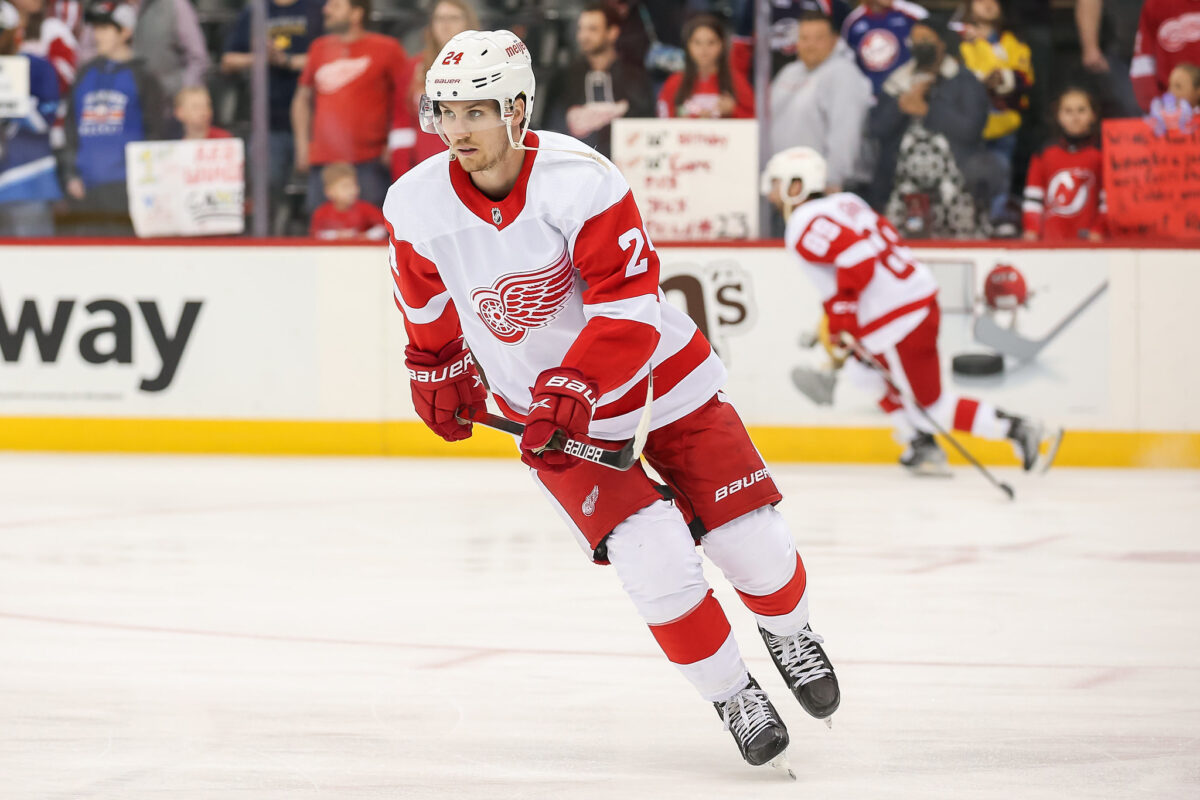
Suter proved to be a useful player in almost any scenario this season. He averaged just under 17 minutes of ice-time per game, and he played a good amount of minutes on both the power play and the penalty kill. The Switzerland-native was a real Swiss Army knife. His 36 points this season did leave something to be desired, especially from a player that spent the vast majority of the season as the team’s second line center. I think he can be a do-it-all third line center for the Red Wings next season, but it wouldn’t surprise me if he either finds himself on the wing or with another team next season.
Vladislav Namestnikov – B-
Through the first quarter of the season, the only thing that impressed me about Namestnikov was his counting stats. He scored in ways that he simply didn’t last season, and that led to a lot more of his jersey-tug celebration that fans fell in love with. Beyond that, he didn’t really move the needle much. It’s not that he was bad, it’s just that he didn’t do a ton to stand out from the crowd.
A little bit before the halfway mark of the season, Namestnikov turned it on and started making plays at both ends of the ice. He was never going to be a huge difference-maker for the Red Wings this season, but it was nice to see him chip in while playing on the top line with Larkin and Raymond at times. He was more of a net positive for the team this season than he was in 2020-21, and it was sad to see him depart at the trade deadline. It was obvious he enjoyed being a Red Wing, but Detroit has at least two players just like him in their pipeline right now. I’m sure fans of the Dallas Stars have grown to like him too.
Robby Fabbri – B-
In last year’s rankings, Robby Fabbri ranked sixth among Red Wings forwards. This year, he was a positive force, but only by a little bit. The coaching staff this season seemed to like him a lot more than I did, considering whenever there was a hole to be plugged on the top line, he was the player that plugged the hole. I really don’t think he’s a center in the NHL, and that’s mostly because I just don’t think he’s dynamic enough in any area of his game to play down the middle.
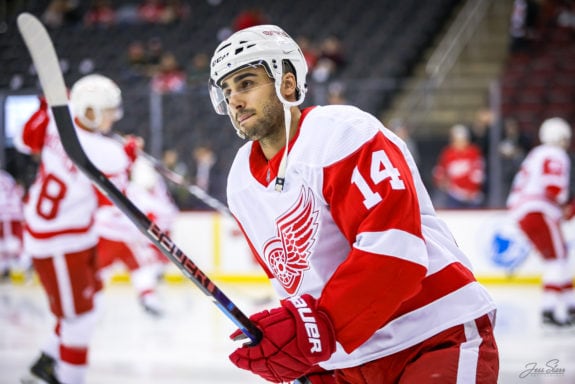
To be clear, I think Fabbri is and was an absolute gamer this season. He works his butt off, and he was able to have a positive effect on the Red Wings this season because of it. Still, for every play he buries, there’s another where he makes you go “what are you thinking, dude?” For various reasons, he still has yet to eclipse 20 goals in a season at the NHL level, and I wouldn’t exactly call him a real playmaker either. After 138 games with the Red Wings, I see him as being a middle six forward that can play with higher-end talent. When he played with Suter and Bertuzzi, I thought he looked really good. There’s nothing wrong with that, but with the flashes that he shows sometimes, it just leaves you wanting a bit more.
Joe Veleno – C
The best part of Joe Veleno’s season was that he entrenched himself as an NHL player. The 30th pick of the 2018 draft showed a lot of good signs this season, but in a season where the Red Wings’ rookies carried the narrative around the team, he was kind of the forgotten rookie in the mix. He compliments Seider well on “The MoJoe Show“, and I think the best part of his game is when the puck is on his stick. He carries the puck well, especially in the offensive zone, and I wouldn’t call him a liability in his own zone either.
However, Veleno is a player that I need to see more from. 16 points through 71 career games isn’t a promising start for a player that has the potential to become a second line center. To be clear: I think he can provide more offense, especially if he sees meaningful time alongside a player like Vrana. The point is that I want to see those good tendencies and instincts lead to production next season because they haven’t to this point. He was fine this season, but I definitely walked away wanting a little bit more from the 22-year-old.
Givani Smith – C
This was supposed to be Givani Smith’s breakout season where he finally earned a full-time role with the Red Wings. Instead, he played 46 games and mostly stood out only when he was punching people. That being said, I value that sort of thing. I’ve seen enough Darren McCarty highlights to know the value of a player that isn’t afraid to drop the gloves. He ranks relatively high here because of that physicality, especially while playing for a team that doesn’t have a ton of players that are willing or able to play that kind of style.
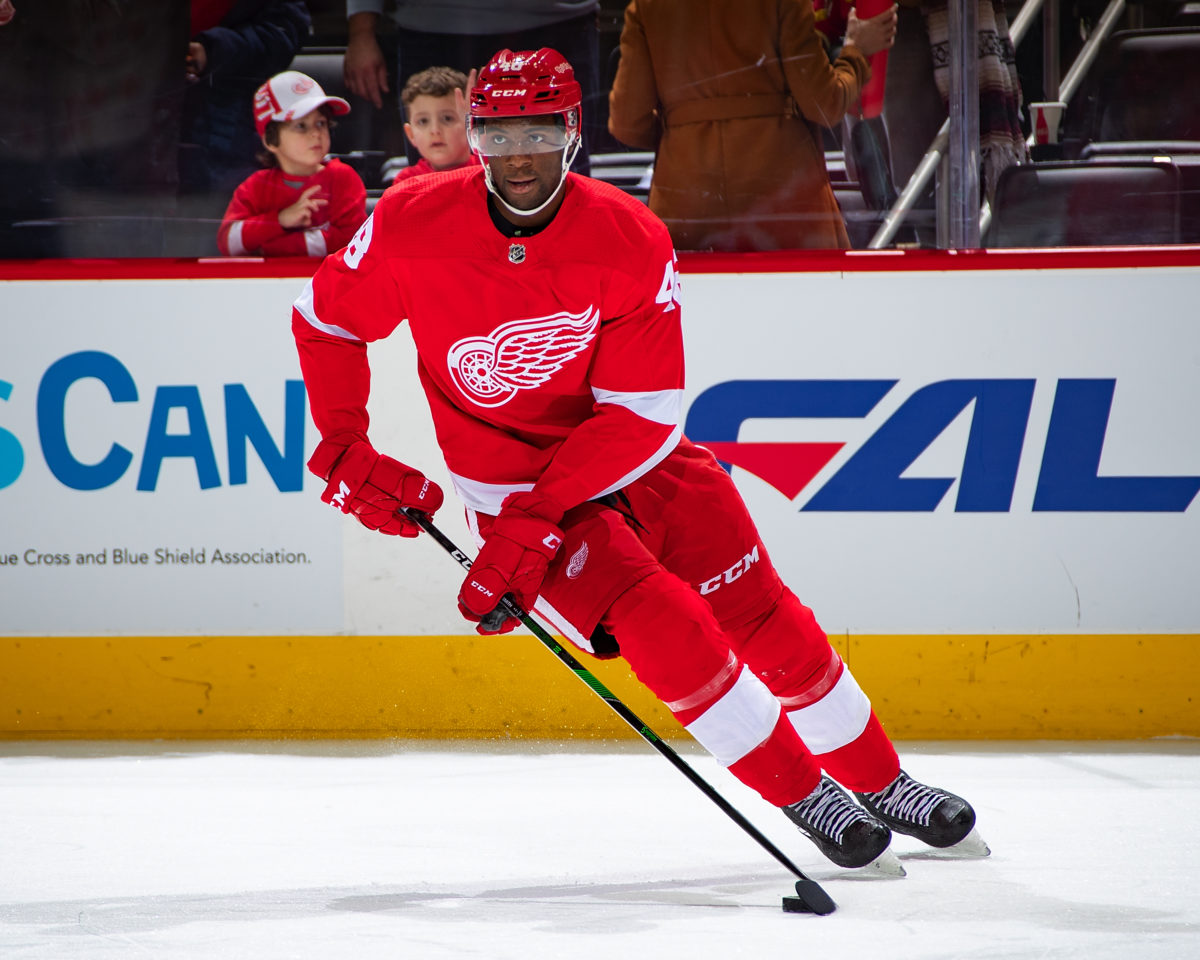
I wish I could grade him higher, but he simply didn’t do enough to earn that full-time spot. That was the expectation and, while I think he did fine in the games he did play, he fell short. At 24 years old, he’s running out of runway to develop into something more. That being said, if all he is at the NHL level is an extra forward that coaches can plug in now and then to add that physical edge, he’ll be more than up to the task.
Mitchell Stephens – C-
I don’t feel like I can accurately evaluate Mitchell Stephens due to his games lost to injury, even though there are players on this list that played fewer games than him. The 25-year-old played just 27 games this season in what was supposed to be his first real shot at holding down a full-time role in the NHL. His skating abilities really impressed me during training camp and the first month of the season. He showed some good instincts too.
Stephens all together came off as a little vanilla for me. As the season went on, he just didn’t stand out the way I hoped he would. There may be something to the idea that his injury did not permit him to ever really get comfortable in Detroit, but with his first real NHL opportunity, I was expecting him to reward Yzerman for the confidence the GM showed in the former Tampa Bay Lightning draft pick. As it is, he seems to be a fine fourth liner that you shouldn’t expect much from.
Filip Zadina – D+
This one hurts. After grading out as the third-best forward last year, Filip Zadina was a net negative for the Red Wings this season, and that’s coming from somebody who is in the “don’t trade Zadina” camp. While there were periods of time this season where he was a positive force, he wasn’t able to make enough of an impact during those stretches, as evidenced by his less-than-ideal stat line (10 goals, 24 points in 74 games).
Related: Red Wings Must Find a Way to Maximize Filip Zadina’s Potential
When Zadina had scoring opportunities, he’d fire the puck into the upper bowl of the arena. When he carried the puck up ice, he’d try to make a fancy move and the defender would easily knock him off the puck. Somewhere along the way, he lost confidence in himself, and that only made things get worse. But when he was on his game, he found his way to the slot, he took confident and dangerous shots, and he hustled to get back on defense. The most frustrating thing about him this season was that you could see the potential that made him the sixth pick in the 2018 draft, but he wasn’t able to put it together with any sort of consistency this season. It was as tough of a season for him to play as it was for us to watch.
Truth be told, I think Zadina might be THE player that benefits most from a new voice behind the bench.
Adam Erne – D
After surprising everyone and leading the Red Wings in goals last season, Adam Erne was closer to the player we were all introduced to during the 2019-20 season than he was to last season’s version. At 27 years old, he is what he is at this point: a fourth line forward whose main objective to grind the opposition down. He’s not as overtly physical as Smith is, but he also doesn’t possess the same offensive upside that Rasmussen does. There are worse options out there, but with a cap-hit of $2.1 million, you could definitely do a lot better than this player.
Erne was a net negative this season. Most of his positive contributions came from making physical and/or defensive plays, and he generally looked way out of place when he was placed in a more offensive role (he spent time on both top six lines this season.) His six goals and 19 points in 79 games reflect the level of player he is. He led the Red Wings in hits with 161.
Carter Rowney – D-
Carter Rowney was basically invisible most nights that he played. Maybe that’s a good thing considering he wasn’t brought in to make a huge difference, but I couldn’t help but think that a prospect like Chase Pearson would have been better off holding down his roster spot. I don’t really have anything bad to say about Rowney, but I also don’t have much good to say either. I think that says a lot.
Red Wings Defense
Moritz Seider – A
Who else was it going to be?
I expected Moritz Seider to come in this season and make a difference. What I didn’t expect was for him to come in and make a case that he already is the Red Wings’ best player. There were stretches of time where he definitely made his fair share of rookie mistakes, especially during the first third of the season when he was still getting acclimated to the NHL, but he was outright dominant by the second half of the season.
There were still instances where the speed of the game caught him off guard, especially in the defensive zone, but I trust that Seider will make those adjustments over time. He broke up plays that would have most certainly resulted in goals last season. Perhaps the most unexpected part of his season what just how productive he was on offense. With 50 points in his rookie season, it’s not hard to imagine him pushing upwards of 80 points a season in his prime. It’s still absolutely insane to think back to his draft day and what people were saying when Yzerman announced the pick.
Marc Staal – B
I did not expect to be saying this, but I really like Marc Staal. In a season where he averaged 17:25 in ice-time (the lowest of his career) he found ways to be a net positive for the Red Wings, which is an improvement from last season. Last year, he was the most “eventful” defenseman on the team based on my observations, and this year he ranked second behind Seider in that regard. On any given night, Staal might stand out for three good reasons and three bad reasons. Stuff just seems to happen when he’s on the ice.
At 35 years old, he was the oldest skater on the team this season. While he certainly doesn’t fit into the long-term picture in Detroit, he’s a well-respected leader on this team, and he fills a position of need in the short-term. Like Gagner, I wouldn’t mind seeing him return next season, though he’s a player that could definitely be replaced if the Red Wings intend on upgrading their defense.
Jake Walman – C+
When Jake Walman was acquired from the St. Louis Blues, I liked the pickup. Through 19 games with the Red Wings, I think he displayed the good in his game quite well; he transports the puck with a buttery-smooth skating stride, and he’s always trying to make something happen on offense. He’s an easy player to like because he’s fun to watch, even if his upside is a bit limited.
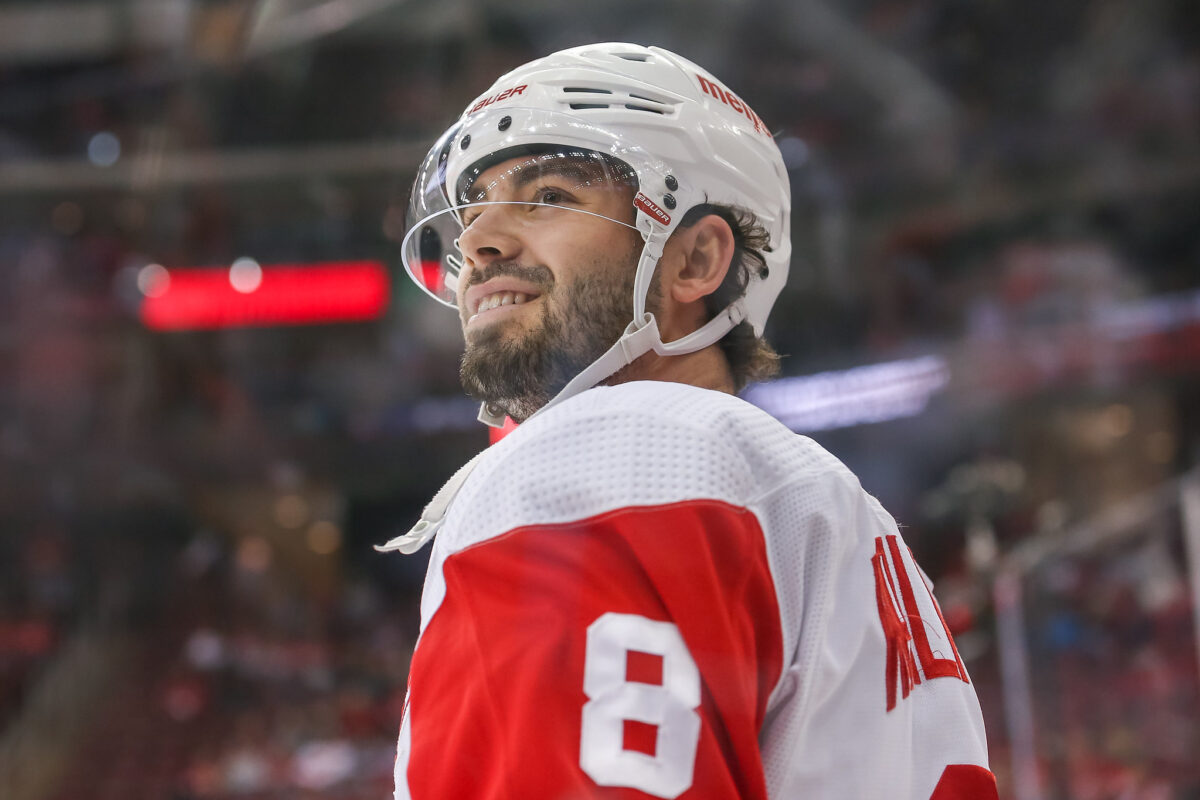
In a weird way, my thoughts on Walman are similar to my thoughts on Veleno. When a player has good instincts and good tools at their disposal, that’s great and necessary for the player to have success. However, at some point it needs to lead to points. To that point, Walman’s .21 points per-game rate with the Red Wings equates to just 17 points over an 82-game season. For a defenseman that is more proficient in the offensive zone than he is in the defensive zone, the points must come. That’s the challenge for him next season because, as much as he made things happen late in the season, I want to see him ACTUALLY make things happen next season.
Jordan Oesterle – C
Realistically, Jordan Oesterle was fine this season. He was a net negative by my observations, but I wasn’t expecting him to come in and be anything more than a seventh defenseman that plays the odd game here and there. Through 45 games, he had eight points and basically confirmed that he is exactly that: a seventh defenseman. There’s really no reason to say anything more.
Gustav Lindstrom – C-
I want to take this opportunity to apologize. In February, I wrote an article praising Gustav Lindstrom, going as far as to say “At best, he might be the Red Wings’ second-best guy on the blue line.” Almost immediately after that article was published, his game fell off a cliff, and he started going in and out of the lineup as the Red Wings started finding playing time for others. I’ll just go ahead and say that I jinxed him.
Related: Red Wings’ Gustav Lindstrom Has Been Underappreciated in 2021-22
When Lindstrom was off his game, he was easy to knock off the puck, he was indecisive, and you’d catch him away from the play in the defensive zone and you’d wonder “what was he doing?” When he was on his game, he was the perfect example of a defenseman that the less you hear their name, the better they’re playing. On paper, he and Walman made for a good pair because their skillsets compliments each other. In practice, it’s obvious that they both have their limitations, especially when going up against seasoned NHL players. Still, I think if Lindstrom takes the lessons he learned this season and applies them during the offseason, he could come into training camp and look like a really sturdy third-pairing, defensive defenseman.
Danny DeKeyser – D
It should tell you how bad things got on defense that Danny DeKeyser is next on this list. I won’t go on too long here because I think it would basically be beating a dead horse, but the Red Wings’ most-tenured player looked like a shell of himself this season. I think he looked better when he returned to lineup after passing through waivers, but that’s like comparing the unemployment rate in the United States in April 2020 vs. May 2020:
Yeah it got better, but it was still bad.
Nick Leddy – D
Nick Leddy had moments this season where you could see exactly why Yzerman went out and got him prior to the Seattle Expansion Draft. He moved the puck well, and his experience was surely a good thing to have in the locker room. But more often than not, he looked inadequate defensively and he didn’t do enough on offense to offset it. There was one game, on Mar. 10 against the Minnesota Wild, where he looked absolutely fantastic, displaying every facet of his game that the Red Wings expected when they acquired him. Besides that game, he was alright at best, and downright awful at worst.
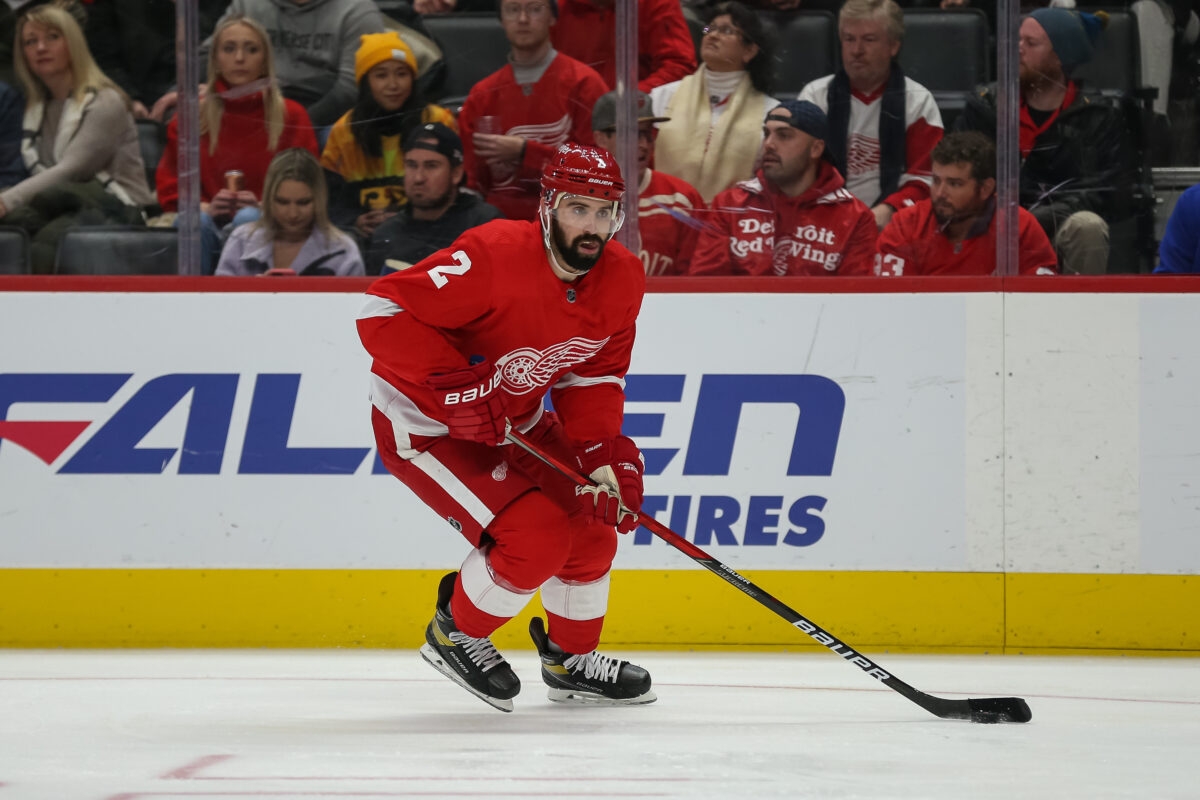
Yzerman did well to squeeze a second round pick, Walman and Oskar Sundqvist out of the Blues in exchange for Leddy. At one point, Leddy was a player that I thought I would like to see re-sign with the Red Wings. Now I hope he enjoys his time in St. Louis and he signs a deal with a team with a much better supporting cast than the one he had in Detroit.
Filip Hronek – D-
Here’s what’s frustrating about Filip Hronek. With 38 points in 78 games, he posted just under a .50 points per-game rate, which is pretty good for a defenseman. There were worse defensemen on the team in terms of how they affected the team’s possession numbers, and he was trusted to play over 22 minutes a game this season. I don’t want to say it was all bad – it wasn’t.
But holy cow, it is painfully obvious that Hronek is not very good at defense.
Hronek is liable to get pinned in his own zone on any given shift, and that’s when things get messy. His most common defense-partner was Leddy, and the two of them together was a heart attack on ice. While Hronek was still able to produce on the offensive side of the puck, it’s hard to look past just how leaky he was and is in his own zone. He needs a quality two-way or defensive-defenseman as his partner. That should allow him to play the offensive game he’s good at while also minimizing the damage he can cause in his own zone. If the plan is to keep Hronek for next season, finding the right partner for him would be at or near the top of my to-do list.
Red Wings Goaltenders
Alex Nedeljkovic – B
Both goaltenders aren’t going to get as much of a write-up as the skaters because I think a lot of their struggles are related to the lack of talent on the blue line. When it comes to evaluating the Red Wings’ goaltenders, it basically comes down to whether or not they gave the team a chance to win.
In the case of Alex Nedeljkovic, I think he gave them a chance to win more often than not. I think he showed that he is not ready at this time to be a true number one goaltender that can play upwards of 60 games a season, but he’s more than capable as a 1A option, so long as the 1B is up to the task as well. The Red Wings went as “Ned” went this season. When he was making saves, the team had a chance on any given night; when he wasn’t making saves, the team spiraled out of control and out of the playoff chase. His season could have gone better, but all-in-all I was not disappointed in his first season with the Red Wings.
Thomas Greiss – D
Thomas Greiss had a quality-start percentage of .500 this season. Basically, he had just as many good starts and he had bad ones, and that’s not what you want from a goalie who was supposed to push Nedeljkovic as the 1B in Detroit. He started the season as strong as he ended it, but in between was filled with a ton of unwatchable performances. He is clearly more of a backup than a 1B at this point in his career, and that’s simply not what the Red Wings need heading into next season.
Final Thoughts
Based on my evaluations, it is clear that this year’s Red Wings team was heavily carried by their top players and their depth players were mostly hit or miss on a given night. Consistency is key in the NHL, and if they’re going to take the next step next season, we’ll need to see more players grade out with A’s and B’s instead of C’s and D’s. This is why rebuilding takes time, and it’s the task that the new head coach will have to tackle.
Like I said at the top, these are all my opinions based on my observations. If you disagree with something here, I would love to hear why. Furthermore, if you have any suggestions on how next year’s grades/evaluations article can be better, drop those in the comments section as well. Until the end of next season, thanks for tuning-in.